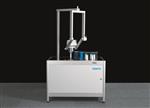Mar 24 2015
Superconductive automation modules are opening up possibilities for new applications
Superconductors are opening up possibilities for entirely new, previously unthinkable applications in automation technology.
 SupraPicker – handling system in a hermetically sealable room.
SupraPicker – handling system in a hermetically sealable room.
Superconductors are opening up possibilities for entirely new, previously unthinkable applications in automation technology. They allow contact-free, frictionless manipulation of objects – efficiently and with minimal energy consumption. Their dust- and abrasion-free operation is ideal for the protective transport of workpieces in highly clean environments. Objects can even be moved from behind walls as the SupraPicker is demonstrating impressively at Anuga FoodTech 2015.
Superconductors are materials which below a certain temperature can “freeze” the field of a permanent magnet at a predefined distance and can thus hold it in suspension. The resulting air gap remains stable in any spatial position. By this means, objects can be stored contact-free without any control technology and be moved with minimal expenditure of energy. “There are already various solutions for storing and moving objects without contact. But only with superconductivity is it possible at the same time to execute a rotation through 360° in any spatial direction – without the need for intricate control technology,” explains Georg Berner, Head of Strategic Corporate Development, Group Holding Festo.
In addition to classic fields of automation such as the suspended low-energy transport of workpieces in production, automation with superconductors can even make inroads into areas of application that until now have been regarded as not or only hardly accessible to automation. Festo has already been investigating superconductor technology and its industrial application for several years.
SupraPicker – handling system in an hermetically sealable room
The SupraPicker exhibit shows a magnetic gripper with superconducting bearing system which completes a two-part handling operation, first outside a hermetically sealable room and then inside this room. The gripper, which hovers thanks to superconductivity, picks up a vial magnetically, conveys it through a lock into a hermetically sealable room and places it in the designated position.
The exhibit showcases the benefits of the non-contacting, stable, superconducting bearing system, which opens up new opportunities for handling applications. Once the magnetic field is stored, the magnet that performs the gripping function and the superconductor can be physically separated without any problems – for example, by a plexiglass wall as in the exhibit. In this application, the superconducting material is actively cooled by a small, electric cooling unit. This does away with the need for auxiliary units for cooling, transporting and storing liquid nitrogen, which makes potential industrial use much easier.
Applications for production of the future
After several years of intensive research work, Festo is cooperating with partners and customers to examine their ideas for specific applications. “We are now not merely showing impressive levitation effects and the opportunities offered by superconductor technology, but are actively discussing their potential together with the automation industry. We are currently working towards initiating our first pilot projects,” said Georg Berner.